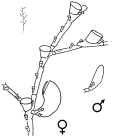RAS taxon details
Halopterididae Millard, 1962
22795 (urn:lsid:marinespecies.org:taxname:22795)
accepted
Family
marine, fresh, terrestrial
recent only
Millard N.A.H. (1962). The Hydrozoa of the south and west coasts of South Africa. Part I. The Plumulariidae. <em>Annals of the South African Museum.</em> 46: 261-319., available online at https://www.biodiversitylibrary.org/page/40867077 [details]
Schuchert, P.; Choong, H.; Galea, H.; Hoeksema, B.; Lindsay, D.; Manko, M.; Pica, D. (2025). World Hydrozoa Database. Halopterididae Millard, 1962. Accessed through: RAS (Eds.) (2025) Register of Antarctic Species at: https://ras.biodiversity.aq/aphia.php/www.pfeil-verlag.de/04biol/rest/aphia.php?p=taxdetails&id=22795 on 2025-09-13
RAS (Eds.) (2025). Register of Antarctic Species. Halopterididae Millard, 1962. Accessed at: https://ras.biodiversity.aq/aphia.php?p=taxdetails&id=22795 on 2025-09-13
Date
action
by
2004-12-21 15:54:05Z
created
db_admin
original description
Millard N.A.H. (1962). The Hydrozoa of the south and west coasts of South Africa. Part I. The Plumulariidae. <em>Annals of the South African Museum.</em> 46: 261-319., available online at https://www.biodiversitylibrary.org/page/40867077 [details]
context source (Hexacorallia) Fautin, Daphne G. (2013). Hexacorallians of the World. (look up in IMIS) [details]
redescription Schuchert P. (1997). Review of the family Halopterididae (Hydrozoa, Cnidaria). <em>Zoologische Verhandelingen, Leiden.</em> 309: 1-162. [details]
context source (Hexacorallia) Fautin, Daphne G. (2013). Hexacorallians of the World. (look up in IMIS) [details]
redescription Schuchert P. (1997). Review of the family Halopterididae (Hydrozoa, Cnidaria). <em>Zoologische Verhandelingen, Leiden.</em> 309: 1-162. [details]
 Present
Present  Inaccurate
Inaccurate  Introduced: alien
Introduced: alien  Containing type locality
Containing type locality
